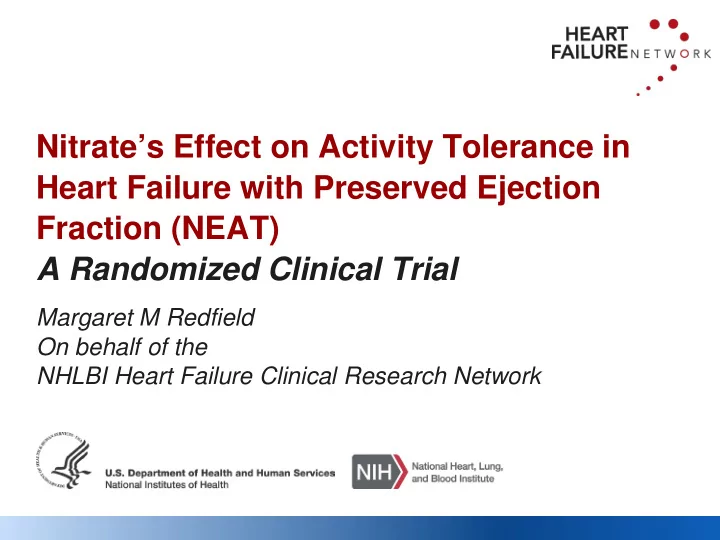

Nitrate’s Effect on Activity Tolerance in Heart Failure with Preserved Ejection Fraction (NEAT) A Randomized Clinical Trial Margaret M Redfield On behalf of the NHLBI Heart Failure Clinical Research Network
Heart Failure Clinical Research Network University of Vermont Medical Center Mayo Clinic Tufts Medical Center Brigham and Women’s Hospital Cleveland Clinic Washington University Jefferson Medical College DCRI Coordinating Center University of Pennsylvania Emory University School of Medicine Duke University School of Medicine Regional Clinical Centers www.hfnetwork.org Coordinating Center
Background • Exercise intolerance is a cardinal feature of HFpEF and perpetuates sedentary behavior, deconditioning and frailty. • Nitrates are commonly prescribed for symptom relief in HFpEF.
Background • The hemodynamic effects of nitrates may attenuate pulmonary congestion with exertion and improve exercise capacity in HFpEF. • HFpEF pts may be at increased risk for nitrate induced hypotension or other side effects. • Ventricular and Vascular Stiffening • Comorbid conditions • Polypharmacy
Background • Patient-worn accelerometers provide continuous assessment of physical activity during daily life. • As compared to intermittent coached exercise tests, daily activity may more accurately reflect the impact of a therapy on patient’s functional status.
Hypothesis • As compared to placebo, isosorbide mononitrate (ISMN) will improve daily activity in HFpEF patients as assessed by patient worn accelerometer devices. • Average daily accelerometer units
Study population • NYHA class II- IV HF symptoms + EF ≥ 50% • Objective evidence of HF (at least one) HF hospitalization Elevated NT-proBNP or BNP Elevated rest or exercise PAWP at RHC Echo Doppler Diastolic Dysf ( ≥ 2 variables) • Identify HF symptoms as the primary factor limiting ability to be active on screening questionnaire Versus neurologic, orthopedic or life-style factors
Study Design : Randomized, double-blind, placebo-controlled crossover study * Or maximally tolerated dose
NEAT Primary End-point • Average daily accelerometer units (AAU) during the 120 mg (or maximally tolerated) dose • Two hip-worn, tri-axial, high sensitivity accelerometers • Worn 24 hours per day (except bathing) • Throughout the entire study
Secondary End-points • Additional accelerometer endpoints • Hours active per day during 120 mg dose • Area under the curve for time and daily accelerometer units during all doses of study drug (30, 60 and 120 mg). • Standard HF endpoints • Six minute walk distance and dyspnea score • HF specific quality of life (KCCQ) • NT-proBNP levels
Crossover Analysis • Intention to treat • Mixed Model: Treatment Effect (ISMN-Placebo) • Sequence effect • Period effect • Random effect of each patient • 110 patients powered to detect : • 43 m difference in 6MWD (>90%) • 5 pts difference in KCCQ (>80%) • 2.5% change relative to baseline in AAU (>90%)
Baseline Features Placebo 1 st ISMN 1 st Characteristic (n=59) (N = 51) Age (years) 69 68 Female 64% 49% White race 92% 86% BMI (kg/m 2 ) 35 36 HF hsp in past year 27% 24% Hx hypertension 92% 88% Hx of coronary disease 61% 63% Diabetes 36% 43% Hx of atrial fibrillation 34% 37% Mean values or % shown All p > 0.05
Baseline Features Placebo 1 st ISMN 1 st Characteristic (n=59) (N = 51) Systolic BP 132 129 NYHA class II/III 56% / 41% 49% / 51% 6MWD (m) 321 300 KCCQ (higher better) 60 55 Ejection fraction (%) 65 62* NT-proBNP (median, pg/ml) 248 210 E/e’ - (normal ≤ 8) 15 15 LAVI (ml/m 2 ) - (normal < 29) 39 41 Rel Wall Th ≥ 0.42 45% 50% *p < 0.05 Mean values or % shown except as noted
Agreement Between Accelerometers R ig h t A c c elero m e ter
Primary Endpoint
Primary and Secondary Endpoints
Other Secondary Endpoints Placebo ISMN P value N=110 N=110 6 Minute Walk Distance (m) 321 322 0.91 Dyspnea (1-10) 3.97 3.89 0.74 KCCQ (Lower worse) 61.6 59.7 0.16 NT-proBNP (pg/ml) 497 550 0.22 Systolic BP (mmHg) 129 125 0.04 Data are the model derived estimates of the mean treatment value
Safety / Tolerability Endpoints Placebo ISMN Characteristic N=110 N=110 Discontinued study drug 9 16 Any Event of Interest 6 14 Arrhythmia 2 2 Worsening HF 1 5 Stroke 0 1 Presyncope/Syncope 3 6 SAE - Death 0 0 SAE - Other 1 2 All p > 0.05
Summary • As compared to placebo, isosorbide mononitrate decreased daily activity levels and did not improve submaximal exercise capacity, quality-of-life scores or NT-proBNP levels in HFpEF patients.
Conclusions • These data do not support use of long acting nitrates for symptom relief in HFpEF. • Patient worn devices provide unique information about the impact of therapies on patients daily functional status
Recommend
More recommend